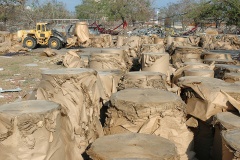Paper (rolls)
| Infobox on Paper (rolls) | |
|---|---|
| Example of Paper (rolls) |  |
| Facts | |
| Origin | This table shows only a selection of the most important countries of origin and should not be throught of as exhaustive
|
| Stowage factor (in m3/t) | 1.78 m³/t (paper rolls wrapped in 6 layers of packing paper). Package dimensions are variable, the important factor being that the rolls within one cargo stack must exhibit uniform dimensions, to prevent distortion. |
| Humidity / moisture |
|
| Ventilation | Recommended ventilation conditions: air exchange rate: 6 changes/hour (airing), if the dew point of the external air is lower than the dew point of the hold air. On voyages from cold to hot climates (Scandinavian ports, Continental ports - tropical unloading ports in Africa, Asia), every possible opportunity for warming the paper must be used to avoid cargo sweat. |
| Risk factors | Self-heating / spontaneous combustion, contamination, wet damage, mechanical influences; see text. |
Paper (rolls)
Contents
Description
Paper (and board) are manufactured from paper pulp. This material is first repulped in water and, after passing through various intermediate operations, such as straining to remove particulate matter, the aqueous slurry of fibres (about 0,5% cellulose fibres) is deposited as a continuous film on a recirculating wire mesh or a moving felt band. The belt passes over suction boxes which removes water from the film to produce a continuous ‘paper’ strip containing about 35% of cellulose. This is sufficiently strong to be stripped off the belt and threaded through a battery of heated rollers where it is further dried so that the paper or board emerging from the end of the machine has a moisture content of about 5%. The warm paper is reeled and possibly slit simultaneously into predetermined sized rolls, by means of continuous reeling equipment.
There are a large number of different types of paper which can be produced by using different types of paper pulp and by various treatments during the paper making operation, such as sizing, opacifying, treatment to produce wet strength, polishing (calendaring), coating etc. It is evident that more complex papers are commercially more valuable than less complex papers. It is also evident that sophisticated paper products which are unacceptable for the intended purpose must either be sold for scrap or returned for repulping. The pulp produced will inevitably be used for low grade products.
Major uses of paper are for newsprint and the manufacture of corrugated fibre board. The paper products used for each application are similar in as much as they are almost always in large, very heavy rolls over half a tonne in weight. Unbleached kraft rolls used for carton board are only slightly less valuable. Because of their weight they must be mechanically handled.
Newsprint rolls are used on high speed printing presses. Any interruption in the printing process, due to a fault in the paper, results in a substantial financial loss. Users take particular care to ensure that only sound rolls which can easily be handled to make them sound, are accepted.
Although the users of kraft paper are not constrained by time in the same way as newspaper publishers, they also employ high speed machinery of high capital cost and take the utmost care to prevent any interruption on a production line.











